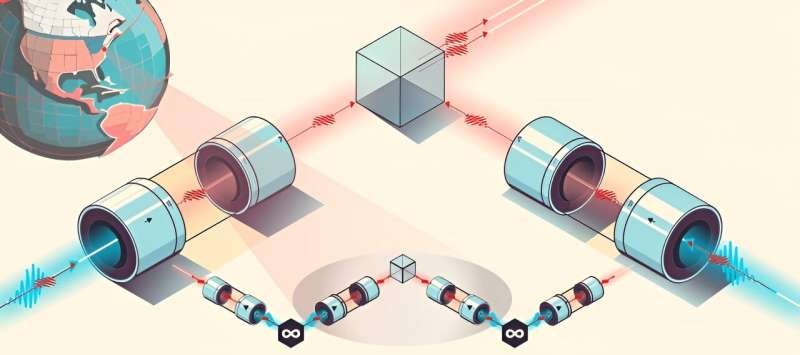Description

Disclaimer: Copyright infringement not intended.
Context
The research conducted by Stony Brook University physicists and their collaborators represents a significant milestone in the development of a functioning quantum internet.
Details
Background
- Quantum computing and quantum networks aim to leverage quantum mechanics to solve complex problems and transmit information securely.
- A quantum internet would consist of quantum computers, sensors, and communication devices capable of creating, processing, and transmitting quantum states and entanglement.
Quantum Repeater Development
- Quantum repeaters are essential for extending the range of quantum communication across multiple nodes and long distances.
- Developing quantum repeaters is one of the complex challenges in current physics research.
Room-Temperature Quantum Memories
- The research team demonstrated room-temperature quantum memories, a significant advancement in quantum repeater technology.
- These memories operate at room temperature, reducing costs and improving speed compared to systems operating at near-absolute zero temperatures.
- They used the Hong-Ou-Mandel Interference process to quantify the indistinguishability of photon properties stored in the memories.

What is the Quantum Internet?
- The quantum internet is a network that enables quantum devices to exchange information using the principles of quantum mechanics.
- Unlike traditional internet protocols, which rely on classical bits (0s and 1s), the quantum internet operates using qubits, which can exist in a superposition of states (0 and 1 simultaneously).
- Quantum communication involves the transmission of qubits across a network of quantum devices, exploiting unique quantum properties such as entanglement and superposition.
Key Concepts:
- Quantum Entanglement: Qubits can be entangled, meaning their states are correlated regardless of the distance between them. Changes to one qubit instantaneously affect the other, enabling secure communication.
- Superposition: Qubits can exist in multiple states simultaneously, offering exponentially more information processing capabilities compared to classical bits.
- Quantum Teleportation: Quantum information can be transmitted using entanglement without the need for physical transmission channels, leading to secure and instantaneous communication.
Applications and Benefits:
- Secure Communication: Quantum communication ensures the security of data transmission through principles such as quantum key distribution (QKD), making it resistant to eavesdropping and hacking.
- Quantum Cryptography: Quantum internet enables the development of ultra-secure encryption methods based on quantum principles, offering provably secure communication channels.
- Distributed Quantum Computing: Quantum networks facilitate distributed quantum computing, allowing multiple quantum processors to collaborate on complex tasks without sharing sensitive information.
- Advanced Sensing and Metrology: Quantum internet enables precise measurements and sensing applications in fields such as astronomy, materials science, and healthcare, leveraging entanglement-enhanced sensing techniques.
Challenges and Future Directions:
- Infrastructure Development: Building a scalable quantum internet infrastructure requires advances in quantum repeaters, entanglement generation, and quantum memory technologies.
- Distance Limitations: Maintaining entanglement over long distances remains a challenge due to decoherence and signal loss, requiring the development of quantum repeaters and satellite-based communication.
- Security Assurance: Ensuring the security and integrity of quantum communication protocols against emerging threats and vulnerabilities is essential for widespread adoption.
- International Collaboration: International cooperation and standardization efforts are necessary to establish interoperable quantum communication networks on a global scale.

Conclusion
In summary, the quantum internet represents a paradigm shift in communication technology, offering unprecedented capabilities in security, computing, and sensing. While still in the early stages of development, the future of quantum networks holds immense promise for transforming various industries and scientific disciplines.
|
PRACTICE QUESTION
Q. Discuss the challenges and potential of developing a quantum internet and its implications for communication and information security. (15 marks)
|















